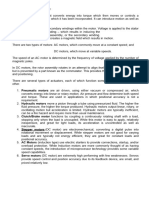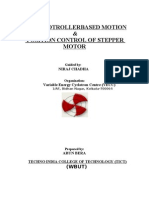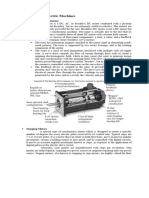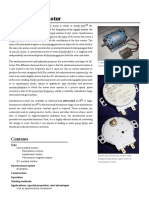Dieu Khien Dong Co Buoc
Uploaded by
nguyenmanhtu_dktdDieu Khien Dong Co Buoc
Uploaded by
nguyenmanhtu_dktdOperation principle of stepper motor
On this page, I will explain about the operation principle of stepper motor. There are many kind of stepper motors. Unipolar type, Bipolar type, Single-phase type, Multi-phase type... Single-phase stepper motor is often used for quartz watch. On this page, I will explain the operation principle of the 2-phase unipolar PM type stepper motor. In the PM type stepper motor, a permanent magnet is used for rotor and coils are put on stator. The stepper motor model which has 4poles is shown in the figure on the left. In case of this motor, step angle of the rotor is 90 degrees. As for four poles, the top and the bottom and either side are a pair. coil, coil and coil, coil correspond respectively. For example, coil and coil are put to the upper and lower pole. coil and coil are rolled up for the direction of the pole to become opposite when applying an electric current to the coil and applying an electric current to the coil. It is similar about and , too. The turn of the motor is controlled by the electric current which pours into , , and . The rotor rotational speed and the direction of the turn can be controlled by this control.
Clockwise control , , and are controlled in the following order. Step angle 0 1 1 0 1 0 0 1 0 0 1 1 1 1 0 0 0 90 180 270
"0" means grounding.
Counterclockwise control , , and are controlled in the following order. Step angle 0 1 0 1 0
0 1 1
1 0 0
1 1 0
0 0 1
-90 -180 -270
"0" means grounding. You can find by the figure, the rotor is stable in the middle of 2 poles of stator. When one side of the stator polarity is changed, the bounce by the magnetism occurs. As a result, the direction of rotor's turn is fixed. The characteristic of stepper motor is the angle can be correctly controlled and to be stable rotates ( It is due to the reliability of the control signal ). Moreover, because the rotor is fixed by the magnetism in the stationary condition as shown in the principle, the stationary power(Stationary torque) is large. It suits the use to make stop at some angle.
The motor which was used this time is 48 steps and the step angle is 7.5 degrees. The way of controlling is the same as the previous example completely. It operates when controlling the electric current of coil, coil, coil and coil. The case of the clockwise control is shown below. The combination of , , and repeats four patterns. Step angle 0 1 1 0 0 1 1 0 0 1 1 0 0 1 1 0 0 1 0 0 1 1 0 0 1 1 0 0 1 1 0 0 1 1 0 0 1 1 0 0 1 1 0 0 1 1 0 0 1 1 0 1 1 0 0 1 1 0 0 1 1 0 0 1 1 0 0 1 0.0 7.5 15.0 22.5 30.0 37.5 45.0 52.5 60.0 67.5 75.0 82.5 90.0 97.5 105.0 112.5 120.0 0 1 1 0 0 1 1 0 0 1 1 0 0 1 1 0 0 1 0 0 1 1 0 0 1 1 0 0 1 1 0 0 1 1 0 0 1 1 0 0 1 1 0 0 1 1 0 0 1 1 0 1 1 0 0 1 1 0 0 1 1 0 0 1 1 0 0 1 Step angle 180.0 187.5 195.0 202.5 210.0 217.5 225.0 232.5 240.0 247.5 255.0 262.5 270.0 277.5 285.0 292.5 300.0
1 1 0 0 1 1 0
0 0 1 1 0 0 1
0 1 1 0 0 1 1
1 0 0 1 1 0 0
127.5 135.0 142.5 150.0 157.5 165.0 172.5
1 1 0 0 1 1 0
0 0 1 1 0 0 1
0 1 1 0 0 1 1
1 0 0 1 1 0 0
307.5 315.0 322.5 330.0 337.5 345.0 352.5
You might also like
- Stepper Motor - Operation, Interfacing and ControlNo ratings yetStepper Motor - Operation, Interfacing and Control11 pages
- Department of Electronics & Communication Course: Microcontroller Based System Design Course Code: ECE-358No ratings yetDepartment of Electronics & Communication Course: Microcontroller Based System Design Course Code: ECE-3588 pages
- Topics Included: Introduction To Stepper Motors & Rotation Sequences Interfacing and Isolating Circuitry Industrial ApplicationsNo ratings yetTopics Included: Introduction To Stepper Motors & Rotation Sequences Interfacing and Isolating Circuitry Industrial Applications20 pages
- Bipolar Stepper Motor Driver 5mm Universal Mounting HubNo ratings yetBipolar Stepper Motor Driver 5mm Universal Mounting Hub12 pages
- Controlling Stepper Motor: Experiment #4No ratings yetControlling Stepper Motor: Experiment #49 pages
- Experiment #09 Stepper Motor Interfacing With Arduino/ Microcontroller Energy ObjectivesNo ratings yetExperiment #09 Stepper Motor Interfacing With Arduino/ Microcontroller Energy Objectives8 pages
- Stepper Motor: Stepper Motors and Their Controllers100% (1)Stepper Motor: Stepper Motors and Their Controllers59 pages
- Special Electrical Machine Stepper Motor NotesNo ratings yetSpecial Electrical Machine Stepper Motor Notes37 pages
- Theory of Stepper Motor 2.1: Drive R Circui T Sequence R Steppe R Moto R Power yNo ratings yetTheory of Stepper Motor 2.1: Drive R Circui T Sequence R Steppe R Moto R Power y14 pages
- System Basics: Delta Precision Motors LTDNo ratings yetSystem Basics: Delta Precision Motors LTD10 pages
- Controlling Stepper/DC/Servo Motors With Arduino/NI DAQ/PMACNo ratings yetControlling Stepper/DC/Servo Motors With Arduino/NI DAQ/PMAC17 pages
- Southern Marine Engineering Desk Reference: Second Edition Volume IiFrom EverandSouthern Marine Engineering Desk Reference: Second Edition Volume IiNo ratings yet
- A New System of Alternating Current Motors and Transformers and Other EssaysFrom EverandA New System of Alternating Current Motors and Transformers and Other Essays5/5 (1)
- How to Run a Lathe - Volume I (Edition 43) The Care and Operation of a Screw-Cutting LatheFrom EverandHow to Run a Lathe - Volume I (Edition 43) The Care and Operation of a Screw-Cutting Lathe4.5/5 (2)
- The Inner Workings of a Watch - A Simple Guide for Enthusiasts of Clockwork MechanismsFrom EverandThe Inner Workings of a Watch - A Simple Guide for Enthusiasts of Clockwork MechanismsNo ratings yet
- The Red Baron’s Ultimate Ducati Desmo Manual: BELT-DRIVEN CAMSHAFTS L-TWINS 1979 TO 2017From EverandThe Red Baron’s Ultimate Ducati Desmo Manual: BELT-DRIVEN CAMSHAFTS L-TWINS 1979 TO 2017No ratings yet
- Shielding of Electromagnetic Waves: Theory and Practice George M. Kunkel - Instantly access the full ebook content in just a few seconds100% (4)Shielding of Electromagnetic Waves: Theory and Practice George M. Kunkel - Instantly access the full ebook content in just a few seconds65 pages
- A Synchronous Motor From A Hammond OrganNo ratings yetA Synchronous Motor From A Hammond Organ8 pages
- "Simulation of Asynchronous Motor Using MATLAB": Submitted To: Prof. GOKULAKRISHNAN GNo ratings yet"Simulation of Asynchronous Motor Using MATLAB": Submitted To: Prof. GOKULAKRISHNAN G35 pages
- Steady State Performance Equations of Induction Motor: B Raja Deepak Srinivas.RNo ratings yetSteady State Performance Equations of Induction Motor: B Raja Deepak Srinivas.R11 pages
- Test Bank For Radiographic Imaging and Exposure 5th Edition by FauberNo ratings yetTest Bank For Radiographic Imaging and Exposure 5th Edition by Fauber7 pages
- Window Tint Performance Data by STEK AutomotiveNo ratings yetWindow Tint Performance Data by STEK Automotive1 page
- Millimeter-Wave Technology Assignment I (20×1)0% (1)Millimeter-Wave Technology Assignment I (20×1)5 pages
- Vaagdevi College of Engineering: Affiliated To JNTUH, Accredited by NBANo ratings yetVaagdevi College of Engineering: Affiliated To JNTUH, Accredited by NBA14 pages
- Digital: 1. Optical Fibers Carry - Data Signals in The Form of Light PulsesNo ratings yetDigital: 1. Optical Fibers Carry - Data Signals in The Form of Light Pulses2 pages
- Electrical Machines I Special Assignment 1No ratings yetElectrical Machines I Special Assignment 13 pages

























































































